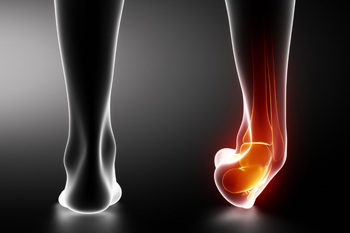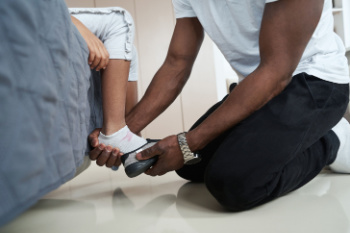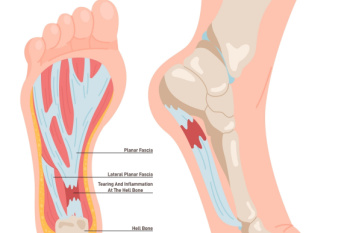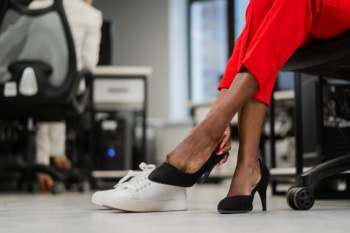Items filtered by date: July 2025
Ankle Fracture? Don’t Wait for Treatment
Healing a Broken Ankle Starts With Walking Sooner

A broken ankle often brings thoughts of rest and staying off your feet completely. However, getting back to walking as soon as your podiatrist says it is safe can actually help your ankle heal better. Walking helps improve blood flow to the injury, reduces swelling, and encourages the bones to heal in the correct position. Avoiding movement for too long can cause muscles to weaken and joints to stiffen, which can make recovery take longer. Your podiatrist may recommend starting with a walking boot to protect the ankle as you slowly begin to bear weight. Controlled movement helps prevent complications like joint stiffness and blood clots. Gentle walking also helps restore strength and balance, especially when combined with targeted exercises designed to support your recovery. If you have broken your ankle, it is suggested you schedule a visit with a podiatrist to create a safe and effective healing plan.
Broken ankles need immediate treatment. If you are seeking treatment, contact Christopher Murphy, DPM from Murphy Foot and Ankle Medicine and Surgery. Our practitioner can provide the care you need to keep you pain-free and on your feet.
Broken Ankles
A broken ankle is experienced when a person fractures their tibia or fibula in the lower leg and ankle area. Both of these bones are attached at the bottom of the leg and combine to form what we know to be our ankle.
When a physician is referring to a break of the ankle, he or she is usually referring to a break in the area where the tibia and fibula are joined to create our ankle joint. Ankles are more prone to fractures because the ankle is an area that suffers a lot of pressure and stress. There are some obvious signs when a person experiences a fractured ankle, and the following symptoms may be present.
Symptoms of a Fractured Ankle
- Excessive pain when the area is touched or when any pressure is placed on the ankle
- Swelling around the area
- Bruising of the area
- Area appears to be deformed
If you suspect an ankle fracture, it is recommended to seek treatment as soon as possible. The sooner you have your podiatrist diagnose the fracture, the quicker you’ll be on the way towards recovery.
If you have any questions, please feel free to contact our offices located in Edgewater Port Orange . We offer the newest diagnostic and treatment technologies for all your foot care needs.
The Hidden Cost of Wearing Poorly Fitting Shoes

Wearing shoes that do not fit properly can lead to a range of painful foot conditions, including blisters, bunions, corns, and even long-term joint problems. Wearing tight or unsupportive footwear places stress on the foot’s structure, often causing inflammation, discomfort, and changes in gait. Choosing the right shoes is essential for maintaining foot health, especially for those who stand or walk for long periods of time. Proper fit includes adequate room for toes, good arch support, and a secure heel. A podiatrist can evaluate your foot type and recommend footwear that promotes comfort and prevents injury. If you are experiencing foot pain or are unsure about your shoe choices, it is suggested that you schedule a visit with a podiatrist for expert guidance and relief.
Getting the right shoe size is an important part of proper foot health. Seek the assistance of Christopher Murphy, DPM from Murphy Foot and Ankle Medicine and Surgery. Our practitioner will provide the care you need to keep you pain-free and on your feet.
Getting the Right Shoe Size
There are many people who wear shoes that are the incorrect size, negatively affecting their feet and posture. Selecting the right shoes is not a difficult process, so long as you keep several things in mind when it comes to choosing the right pair.
- When visiting the shoe store, use the tools available to measure your foot.
- Be sure there is ‘wiggle room’. There should be about an inch between your toes and the tip of your shoes.
- Do not always assume you are the same size, as manufacturers run differently.
- Purchase shoes later in the day, as your feet swell as the day progresses.
- If a shoe is not comfortable, it is not suitable. Most shoes can’t be ‘broken in’, and comfort should be the ultimate goal when it comes to choosing the right pair of shoes
As our feet hold our body weight and keep us moving, it is important to treat them right. Picking the right pair of shoes can provide your feet comfort and mobility without pain.
If you have any questions, please feel free to contact our offices located in Edgewater Port Orange . We offer the newest diagnostic and treatment technologies for all your foot care needs.
Exploring Plantar Fasciitis Surgery

Plantar fasciitis is a painful foot condition caused by strain and inflammation of the plantar fascia. This band of tissue supports the arch and connects the heel to the front of the foot. When the plantar fascia becomes damaged, ongoing heel pain may interfere with walking or standing. When pain continues for 12 months or more despite consistent medical treatment, surgery may be considered. A podiatrist may perform a plantar fasciotomy, which involves cutting part of the fascia to relieve tension. This procedure can be done in traditional open surgery or with a less invasive endoscopic method. Recovery generally begins with limited weight-bearing, with many people walking more comfortably within a few weeks and returning to full activity within two months. While surgery for plantar fasciitis is not needed in most cases, it may help reduce long-term pain and restore foot function when other options have failed. If you have foot pain from plantar fasciitis, it is suggested that you schedule an appointment with a podiatrist to determine whether surgery is an option.
Foot surgery is sometimes necessary to treat a foot ailment. To learn more, contact Christopher Murphy, DPM of Murphy Foot and Ankle Medicine and Surgery. Our practitioner will assist you with all of your foot and ankle needs.
When Is Surgery Necessary?
Foot and ankle surgery is generally reserved for cases in which less invasive, conservative procedures have failed to alleviate the problem. Some of the cases in which surgery may be necessary include:
- Removing foot deformities like bunions and bone spurs
- Severe arthritis that has caused bone issues
- Cosmetic reconstruction
What Types of Surgery Are There?
The type of surgery you receive will depend on the nature of the problem you have. Some of the possible surgeries include:
- Bunionectomy for painful bunions
- Surgical fusion for realignment of bones
- Neuropathy decompression surgery to treat nerve damage
Benefits of Surgery
Although surgery is usually a last resort, it can provide more complete pain relief compared to non-surgical methods and may allow you to finally resume full activity.
Surgical techniques have also become increasingly sophisticated. Techniques like endoscopic surgery allow for smaller incisions and faster recovery times.
If you have any questions, please feel free to contact our offices located in Edgewater Port Orange . We offer the newest diagnostic and treatment technologies for all your foot care needs.
The Impact of High Heels on Foot Health

Wearing high heels regularly can significantly affect foot structure and movement. Heels alter natural gait, forcing the body to lean forward and placing excess pressure on the ball of the foot. This unnatural position can lead to pain, calluses, and long-term joint stress. High heels also create ankle instability, increasing the risk of sprains or fractures from sudden twists or missteps. Over time, frequent use may lead to chronic foot discomfort and toe deformities. A podiatrist can evaluate foot health, provide relief strategies, and recommend supportive footwear alternatives. If you experience foot pain from wearing heels, it is suggested that you seek guidance from a podiatrist to restore comfort, improve balance, and protect your feet from further damage or injury.
High heels have a history of causing foot and ankle problems. If you have any concerns about your feet or ankles, contact Christopher Murphy, DPM from Murphy Foot and Ankle Medicine and Surgery. Our practitioner can provide the care you need to keep you pain-free and on your feet.
Effects of High Heels on the Feet
High heels are popular shoes among women because of their many styles and societal appeal. Despite this, high heels can still cause many health problems if worn too frequently.
Which Parts of My Body Will Be Affected by High Heels?
- Ankle Joints
- Achilles Tendon – May shorten and stiffen with prolonged wear
- Balls of the Feet
- Knees – Heels cause the knees to bend constantly, creating stress on them
- Back – They decrease the spine’s ability to absorb shock, which may lead to back pain. The vertebrae of the lower back may compress.
What Kinds of Foot Problems Can Develop from Wearing High Heels?
- Corns
- Calluses
- Hammertoe
- Bunions
- Morton’s Neuroma
- Plantar Fasciitis
How Can I Still Wear High Heels and Maintain Foot Health?
If you want to wear high heeled shoes, make sure that you are not wearing them every day, as this will help prevent long term physical problems. Try wearing thicker heels as opposed to stilettos to distribute weight more evenly across the feet. Always make sure you are wearing the proper shoes for the right occasion, such as sneakers for exercising. If you walk to work, try carrying your heels with you and changing into them once you arrive at work. Adding inserts to your heels can help cushion your feet and absorb shock. Full foot inserts or metatarsal pads are available.
If you have any questions, please feel free to contact our offices located in Edgewater Port Orange . We offer the newest diagnostic and treatment technologies for all your foot care needs.
Common Causes of Heel Pain

Heel pain often comes from a few common issues in the foot and heel area. One frequent cause of heel pain is plantar fasciitis, which involves micro‑tears in the fibrous band under the foot where it meets the heel bone. Heel spurs can develop as a bone growth at that same connection. Although sometimes symptomless, they can accompany ongoing plantar fascia discomfort. In active adolescent children, Sever’s disease is caused by inflammation of the growth plate at the back of the heel. It typically occurs when their activity level increases or from wearing improper footwear. Wearing tight shoes can cause a so-called pump bump on the back of the heel, which can become painful when walking. A podiatrist can evaluate these sources of heel pain with an exam and imaging tests to determine a treatment plan. If you are experiencing persistent heel pain, it is suggested that you schedule an appointment with a podiatrist for a diagnosis and appropriate treatment.
Many people suffer from bouts of heel pain. For more information, contact Christopher Murphy, DPM of Murphy Foot and Ankle Medicine and Surgery. Our practitioner can provide the care you need to keep you pain-free and on your feet.
Causes of Heel Pain
Heel pain is often associated with plantar fasciitis. The plantar fascia is a band of tissues that extends along the bottom of the foot. A rip or tear in this ligament can cause inflammation of the tissue.
Achilles tendonitis is another cause of heel pain. Inflammation of the Achilles tendon will cause pain from fractures and muscle tearing. Lack of flexibility is also another symptom.
Heel spurs are another cause of pain. When the tissues of the plantar fascia undergo a great deal of stress, it can lead to ligament separation from the heel bone, causing heel spurs.
Why Might Heel Pain Occur?
- Wearing ill-fitting shoes
- Wearing non-supportive shoes
- Weight change
- Excessive running
Treatments
Heel pain should be treated as soon as possible for immediate results. Keeping your feet in a stress-free environment will help. If you suffer from Achilles tendonitis or plantar fasciitis, applying ice will reduce the swelling. Stretching before an exercise like running will help the muscles. Using all these tips will help make heel pain a condition of the past.
If you have any questions, please feel free to contact our offices located in Edgewater Port Orange . We offer the newest diagnostic and treatment technologies for all your foot care needs.

